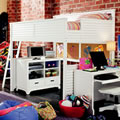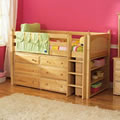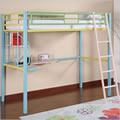Buyers' Guide: Materials
Materials
Bunk beds are made of either wood or metal, or, in some cases, a combination of the two. Both are viable options, with their pros and their cons. Wood is a prevalent choice among manufacturers, but metal bunk and loft beds do have their place in the market.
Sturdiness and durability are two of the most sought after qualities in a bunk bed for kids, and both wooden and metal products, if properly built, should hold their own in this department. Flimsiness, rickety appearance, or anything of the sort, are likely due to either poor design or build quality, rather than choice of material.
Metal bunk beds exude a modern, contemporary look. They can be constructed of steel tubes, metal rods or wrought iron. Tubular design is the most common type -- when speaking of metal bunkbeds alone -- found on the market today. Such beds are generally considerably lighter than wooden ones; this is a good thing to have in mind if, for some reason, you plan to move them around a lot. Quality metal products are coated with so called powder-coat finish which is considerably tougher than conventional paint and offers a much better resistance toward scratching, chipping, UV damage and rust. Plus it looks great.
Since metal allows for relatively easy shaping, many modern metal bunk beds feature appealing curvy forms adding to their attractiveness. They are also somewhat less expensive, which is due partly to lower production costs, and partly to their simplicity; metal bunk and loftbeds generally come with less optional items and additions than their wooden counterparts and that reflects in the price.
Although metal is not to be discounted as a bunk bed building material, wooden bunk beds still constitute more than three quarters of the market today; consequently, they come in a significantly larger variety of shapes, styles and arrangements and offer much more in the way of optional items, from ladder types to stairs to drawers and trundles and all those nooks and crannies that kids just seem to adore.
There are several types of woods used in manufacturing quality kids furniture:
Maple -- a favorite of American furniture makers since early Colonial days. The wood is hard and heavy, with high resistance to abrasion and wear. It has a close, fine, uniform texture. Color: creamy white to dark reddish brown. Pre-boring is recommended when nailing and screwing. It machines well, glues satisfactorily, and can be stained to an outstanding finish. Polishes well and is suitable for enamel finishes and brown tones.
Oak -- a hard and heavy wood with medium bending and crushing strength. Very good in steam bending, great wear-resistance. It has a medium to coarse texture, with pronounced figure. Color: white to light brown to pinkish-redish brown, depending on the species. Oak wood machines well, nailing and screwing are good (although pre-boring is recommended) and it can be stained with a wide range of finish tones.
Cherry -- the wood is of medium density with good bending properties and medium strength and shock resistance. It has a fine, uniform, straight grain, smooth and satiny texture, and may naturally contain brown pith flecks and small gum pockets. Color: the heartwood of cherry varies from rich red to reddish brown and will darken with age and on exposure to light. Cherry is easy to machine, nails and glues well and, when sanded and stained, it produces an excellent smooth finish.
Walnut -- a tough hardwood of medium density, with moderate bending and crushing strengths. It is generally straight-grained, but sometimes with wavy or curly grain that produces an attractive and decorative figure. In fact, this species produces a greater variety of figure types than any other. Color: the heartwood is light brown to dark chocolate brown, occasionally with a purplish cast and darker streaks. The wood develops a rich patina that grows more lustrous with age. Walnut works easily with hand and machine tools, and nails, screws and glues well. It holds paint and stain very well for an exceptional finish and is readily polished.
Rubberwood -- an Asian hardwood, also known as Eco-friendly Hardwood, or the Rubber Tree, the wood is used in the manufacture of high-end furniture. It is valued for its dense grain, stability, attractive color and acceptance of different finishes. It is also prized as an "environmentally friendly" wood, since it makes use of trees that have been cut down at the end of their latex-producing life cycle and are always replaced with new seedlings.
Pine -- a soft wood with a knotted look. It has low strength and shock resistance, moderately low decay resistance, but is very stable in service, it will hold together well. The wood is straight and even grained with a medium to coarse texture. Color: creamy white, pale yellow or light brown. Works very well with machine or hand tools, glues satisfactorily and holds nails and screws well without the need to pre-drill. Paints and finishes fairly well. Pine is often times used to create a rustic or antique look for furniture.
Engineered wood -- also known as composite wood, it is, as the name implies, manufactured by bonding together wood strands, particles, veneers, lumber or other forms of wood fiber to produce a larger and integral composite unit that is stronger and stiffer than the sum of its parts. Types of engineered wood most often used in furniture manufacture are MDF (medium density fiberboard) and veneer. MDF is made from fine wood dust mixed with a binder (a special sort of glue) and heat-pressed into panels. It is extremely stable to work with, and is typically very consistent from batch to batch. The material is easy to machine and the cut edges are excellent for glue adhesion. Veneer refers to thin slices of wood that are glued onto core panels (typically, wood, particle board or medium density fiberboard) to produce flat panels. This results in a strong but light weight material, an easy one to handle. Engineered wood has a few advantages over solid wood, the main one being a balanced or uniform surface design -- veneer can incorporate beautiful symmetric and consistent grain patterns and can be shaped into graceful curves which is not possible with solid wood. Furthermore, manufactured wood can be made of recycled materials, and finally, with today's advanced manufacturing processes composite materials are often even stronger and more durable than their solid counterparts.
To learn more about hardwood materials presented above, visit the American Hardwood Information Center.
Bottom line:
In the end, the choice between wood and metal comes down to aesthetics and functionality; for some environments, metal bunk beds with their simplicity and contemporary look will just be a natural fit, but for most people bunk and loft beds made of wood will still be the primary choice, as they will simply better blend in with the rest of the furniture that may already be in the room, and/or better suit their personality. Then there is the versatility: wooden bunk beds come in a much larger variety of styles and configurations and usually have a greater assortment of optional items available -- there is really something for anyone's taste, budget, or specific need.

Atlantic Furniture Colorado Twin over Twin Bunk Bed
Best Price: $837.90

Lea Furniture Freetime Full Size Loft Bed
Best Price: $1,229.99

Maxtrix Kids Twin Size Low Loft Bed with Dresser and Bookcase
Best Price: $1,846.00

Powell Sunday Funnies Twin Size Metal Loft Bed
Best Price: N/A

Night and Day Ginger Full over Full Bunk Bed in Chocolate
Best Price: $875.99

